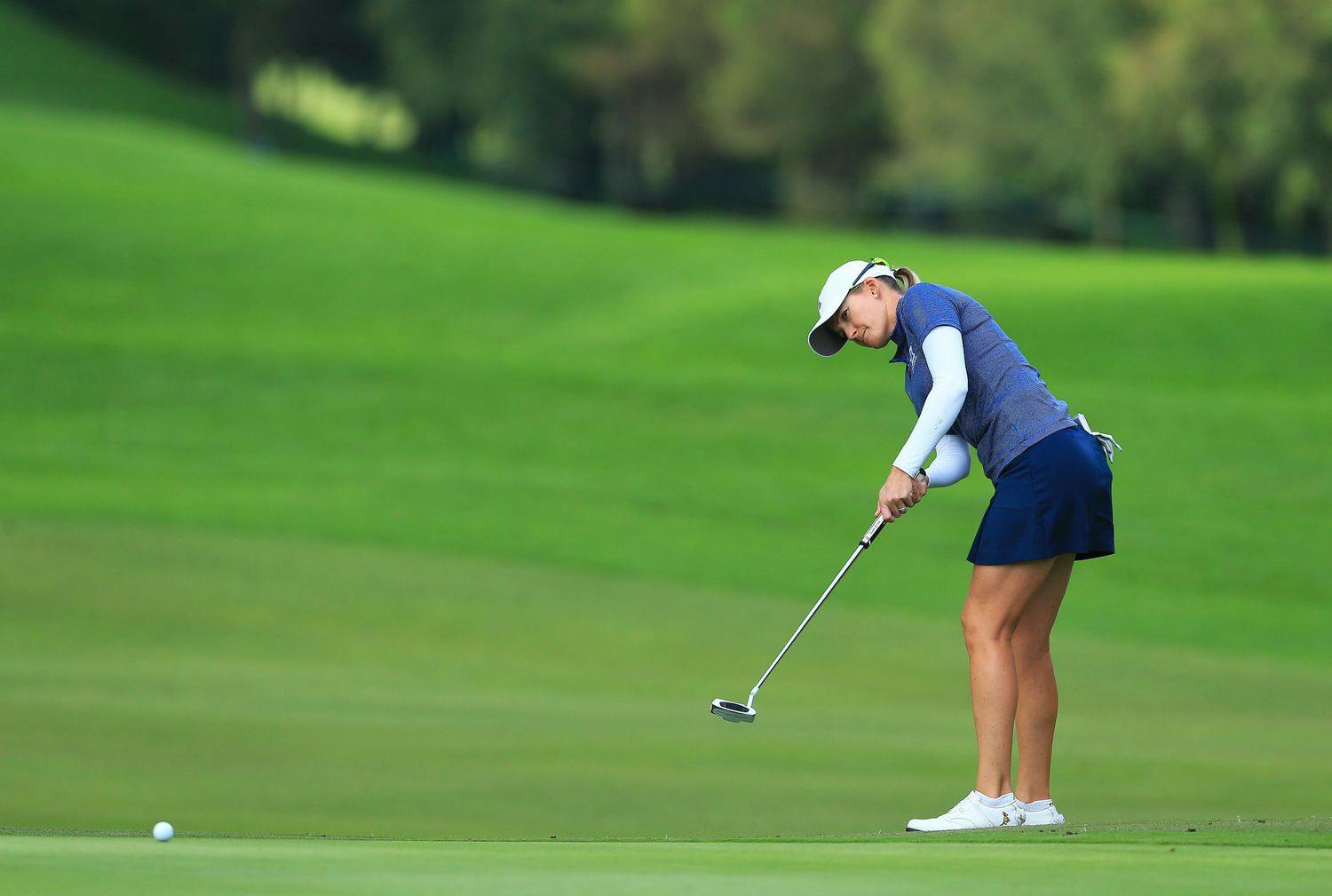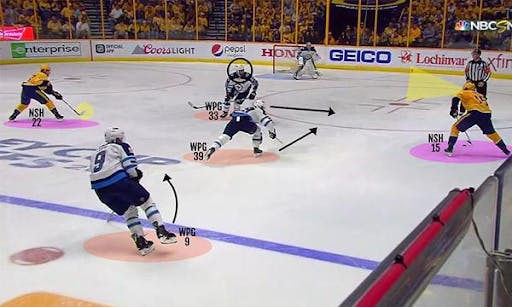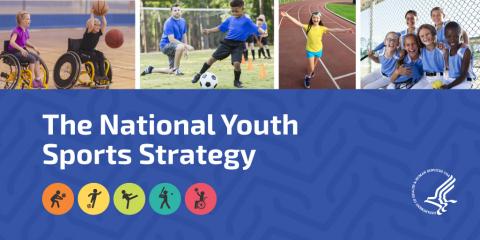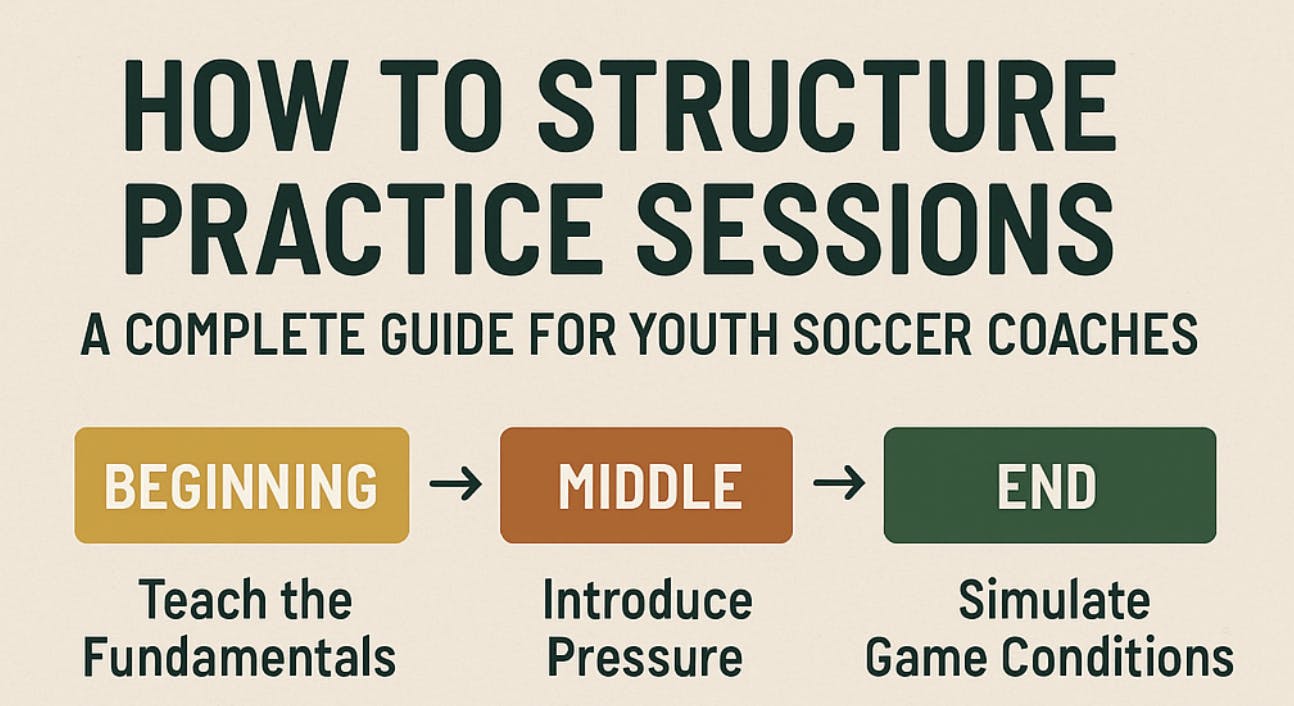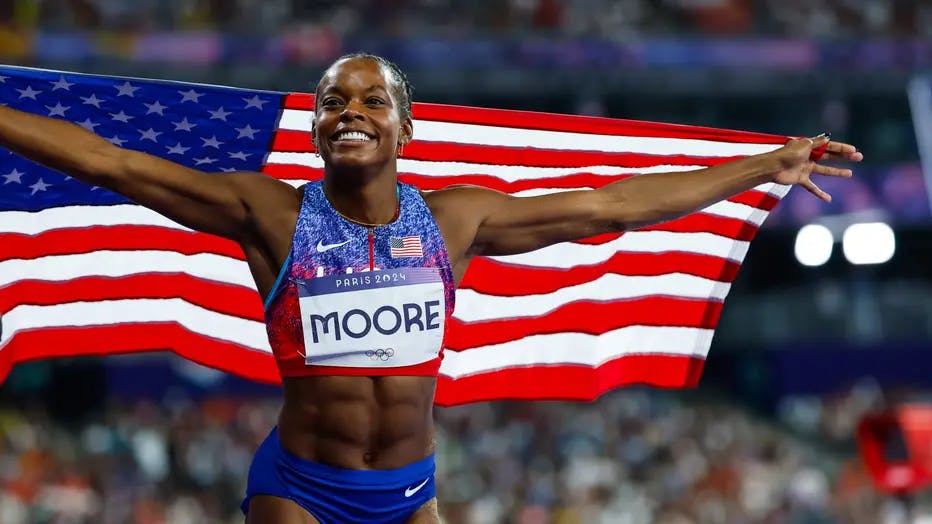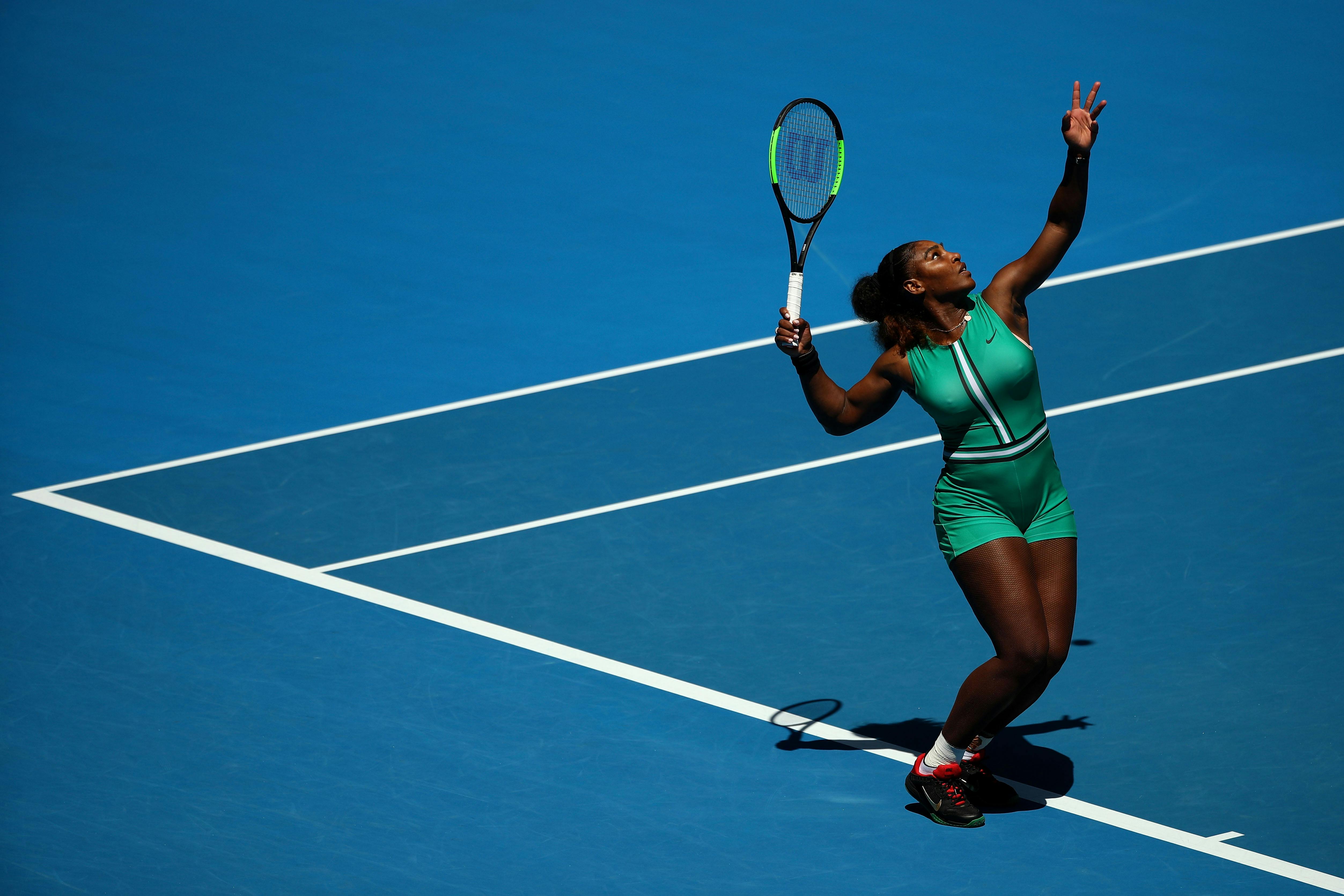Wednesday, April 16, 2025
US Sports Golf: Three Ways to Make More Difficult Putts and Random Club Challenge Alexa Pano vs. Nataliya Guseva
Bombs Away In The Bronx! Now Streaming On US Sports Radio!
- By Grant Young
Putting in golf can be incredibly frustrating. The delicate nature of judging the green, coupled with the pressure to execute a flawless stroke, often leads to intense frustration when putts don't go as planned. Even the smallest mishaps in alignment or speed can result in a missed putt, making it a source of frustration for golfers at all levels.
Putting is difficult for several reasons. Firstly, reading the greens accurately to determine the break and speed of the putt is a highly challenging task. Additionally, maintaining a smooth and consistent putting stroke, especially under pressure, is crucial for success. The smallest error in alignment or pace can result in the ball missing the hole, making it a mentally and physically demanding aspect of the game. And because putting can seem so hopeless for even the most seasoned golfers, the failure to perform on the putting green can ruin an otherwise great day at the course.
There are plenty of putting lessons online where you can glean some solid tips on how to improve various aspects of your game. But there is only one Geoff Mangum.
0:00 / 0:00
15 seconds
15 seconds
Coach Geoff Mangum has spent over 25 years researching and studying everything there is to know about putting. He is recognized as the world's top expert in how the brain and vision work when targeting and making movements in putting. His unique approach combines traditional knowledge with modern science.
Mangum is one of the top putting coaches in the world and has a very successful website called puttingzone.com, where Mangum has been investigating the science of how the brain and body operate to perform the “skills” of putting for the first (and still the only time) in golf history, revolutionizing the game that has long only taught ad hoc tips and drills mostly for stroke alone, but without teaching how perceptions form and guide movements and how “brains do ‘physics’ predicting and executing reading, aiming, stroke, and touch”.
Coach Mangum’s ‘Reading Greens and Making Putts’ course discloses many tips that only someone who has dedicated their life to putting can glean. Regardless of where on your golf journey you are right now, the following bits of advice from Coach Mangum are guaranteed to improve your game on the green.
Lag Putting
Knowing how to execute a proper lag putt on the green can make a major difference on a scorecard. For anyone who doesn’t know, A lag putt in golf is a long putt that a golfer attempts to get close to the cup but doesn't expect to make. The goal is to get the ball within a 3-foot circle around the cup when making the putt.
Coach Mangum has a rule of thumb to improve a golfer’s lag putts. He recommends that the distance should always be to the fall line on the high side of the hole, which should make for a relatively accurate target to aim for when making the lag putt.
For the rule of thumb, Coach Mangum first wants golfers to imagine the general average slope grade of the section of the green you’re putting on, which will get you some general percentage (for a rather steep green, it would be about 4%).
Then you will want to count the number of military paces there is between where you ball in and the hole. Finally, you will want to multiply that number by the percentage you took earlier and will use that answer to find out how many inches you want to aim up the fall line from the center of the hole.
While this is going to involve a lot of guesswork if you’re able to estimate nearly enough of all of these figures and execute the putt to that new target, Coach Mangum is convinced you’ll produce a putt you’re proud of.
Difficult Putts
When it comes to having to make a difficult put on a steep surface, the first read you will want to make as it pertains to making the putt is the surface flatness of where the actual hole is located. Once you have a good idea of that, that will provide a solid baseline of where to angle a putt.
After doing so, you will want to figure out where the green’s contour lines are. Contour lines show the green's topography and slope, which can help golfers determine their putting line because of how they indicate the slope’s severity.
Essentially, you’ll be looking for a line where the steepness of the green changes. Once you do so, you’ll figure out that the fall line (an imaginary line that runs through the center of the cup and indicates the direction of a straight downhill putt) is going to be exactly perpendicular to that contour line. This will help you line up where you should be aiming your difficult putt.
Closing Comments
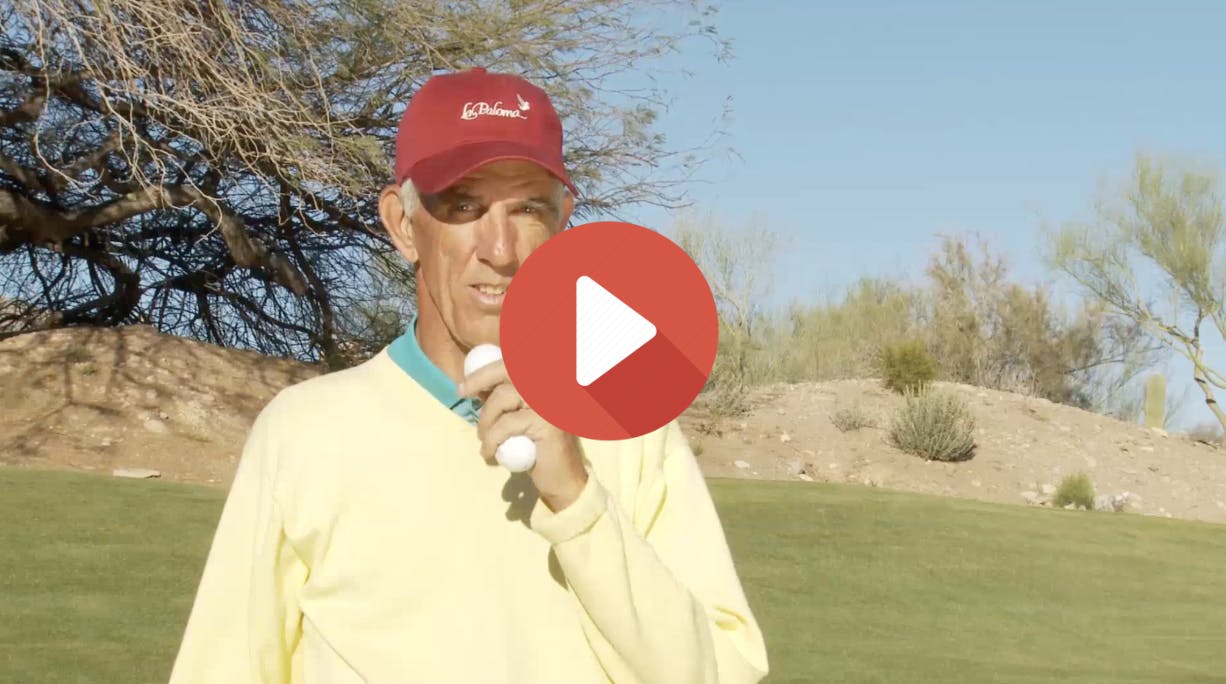
While there are numerous calculations and reads that Coach Mangum referenced that can be beneficial to improving your putting, his bottom line is that putting well is always going to come down to touch.
What he means by this is that having a consistent delivery speed (the firmness with which you’re connecting your putter to the ball) when putting is what truly differentiates between good and great golfers.
While
some of this is natural, any golfer can hone their touch by consciously
thinking about it while playing and spending a put of time on the
putting greens. In other words, the best way to become a better putter is to actually go out and practice your putting.
Tuesday, April 15, 2025
US Sports Ice Hockey: 4 Hockey Passing Drills to Improve Team Performance: Mites to Peewees and Kings vs. Oilers Highlights
NBA, NHL Playoffs Are Here. Now Streaming On US Sports Radio!
- By Jackson Chlebowy
Ice Hockey is a fast-paced game that requires precision, teamwork, and quick decision-making. Plays can occur in a matter of seconds, requiring players to think strategically while successfully executing their skills. The dynamic and fast nature of the game makes mastering passing essential for both individual and team performance. Hockey passing drills are integral for developing accuracy, timing, and communication on the ice. Whether you're a beginner or an experienced player, incorporating these drills into your practice routine will elevate your game and strengthen team dynamics.
Why are Passing Drills Important?
Passing is more than moving the puck from player to player. It’s about creating scoring opportunities, controlling and maintaining puck possession, and keeping your opponents on their toes. Effective passing can be the difference between a good team, and a great one. At the beginner level, passing drills allow players to develop their accuracy and puck-handling skills. At the more experienced levels, Passing drills allow players to simulate in-game situations where they can learn, adapt, and react to different game scenarios. Hockey passing drills can improve:
- Puck Control: Learning to pass, and receive passes under pressure will enhance players' ability to control play and keep the puck moving. It will also train players to make smart decisions with the puck to maintain team possession and control play.
- Team Chemistry and Communication: Practicing passes, and passing scenarios will improve team communication and understanding on the ice. Through consistent practice and repetitions teammates will become better communicators on the ice, and learn each other's tendencies or preferences. This can help teams get on the same page, reducing the potential for costly turnovers and broken plays.
- Quick and Intelligent Decision-Making: Hockey is a game of time and space. Quick and accurate passes help your team play faster and more efficiently. Minimizing time spent in possession of the puck will allow your team to rapidly move the puck down the ice or away from danger, exploiting holes in the defense before they are able to adjust or react. This faster tempo can create dangerous scoring opportunities and odd-man-rush situations.
4 Hockey Passing Drills to Improve Team Performance: Mites to Peewees
Here are four passing drills, starting with the basics, that will help your team dominate this upcoming hockey season.
Partner Passing
Partner passing is a simple and easy passing drill for building up the basics of giving and receiving a pass. Coach Patrick Burke, a former college hockey player and successful coach explains the fundamentals of passing in his ‘Coaching Youth Hockey: From Mites to PeeWees’ course. Coach Burke has a strong focus on player and skill development and has led championship-winning teams at the high school varsity level. He has years of coaching experience at nearly every level of the game, from mites to college.
Have each player choose a partner, and line them up 5ft-10ft from one another. Each pair will have 1 puck between them and will practice passing back in forth to one another, focusing on making crisp tape-to-tape passes with their forehand and backhand. Emphasize the importance of “soft hands”, in this drill when receiving and passing the puck.
Passes should be made with a sweeping motion, not a slap. When receiving the pass players should cradle the puck, catching it like a slingshot. This will give the player more control, and allow them to load up for a quick pass back. Make sure players have their heads up when passing and receiving; Looking at their target, not the puck. Once players are comfortable at 5ft-10ft, have them move further and further away.
The Box Drill
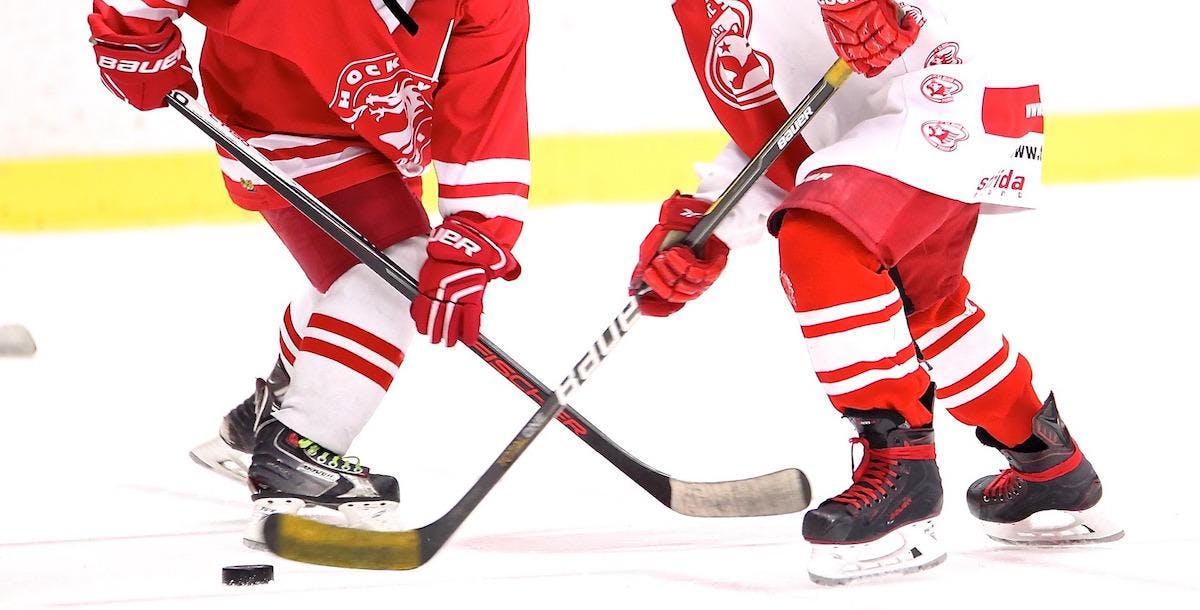
This is another important drill from Coach Patrick Burke (Click above). In Coach Burkes ‘Coaching Youth Hockey: From Mites to PeeWees’, he explains the importance of following, not watching your passes.
The Drill is simple. Place 4-6 players in a box or along a faceoff circle. The players will pass the puck to one another, following their pass each time and remaining ready for an incoming pass. This gets players out of the habit of watching their passes and taking themselves out of the play. Young players must understand the importance of moving their feet after passing. Rarely in hockey are plays made while stationary. Getting in the habit of moving their feet, and being ready to receive a pass at any time will allow them to support their teammates and beat their opponents to open space.
2 Player Slot Passing Drill
This is a more intermediate drill that can be used for most skill levels and age groups. The 2-player slot drill emphasizes the importance of timing (from both the passer and receiver) communication and, the ability to cleanly catch and release the puck on the net. Being able to find your teammates quickly, and release the puck effectively in dangerous areas of the ice will help create and convert on more scoring chances.
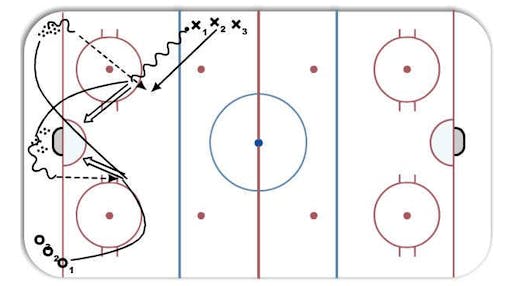
Start by splitting the team into 2 groups (they should alternate groups as the drill goes on), one group at the blue line on either side of the ice and the other group in the corner diagonally across. Set up 2 piles of pucks, one behind the net and the other in the empty corner. The drill will begin at the point with one puck (after this, the drill can continuously run without stopping and starting). Have this player skate into the slot and take a shot on net. After the shot, skate behind the net to pick up a puck. The player in the corner should begin skating around the top of the circle, timing it so that he reaches the apex of the circle as the player with the puck is ready to pass. He/she then receives the pass in the slot for a shot on the net. After the shot, he/she then skates to the far side corner with the 2nd pile of pucks to make a pass to the next player in line at the point. Restarting the drill over again with new players.
Players throughout the drill should communicate with each other, calling for passes and presenting themselves for scoring opportunities. Never during this drill should a pass be made to a stationary target, players should time their portion of the drill to receive the pass in, or around the slot area.
Breakout/Regroup Drill
The Breakout/Regroup drill is a more advanced drill used to simulate real game scenarios. This drill simulates the breakout/regroup and gives players the opportunity to practice quick decision-making and communication with their teammates. A swift and effective breakout is essential for starting the transition from defense to offense. A well-conducted breakout can alleviate pressure in the defensive zone and create odd-man opportunities going the other way. The regroup and transition game is all about finding open teammates and attacking the weak areas of the ice. Players should keep their heads up at all times, looking to exploit open ice with a pass, or with their feet. Being in the position to make a play is just as important as the pass.
Begin the drill with 2 defensemen on both blue lines (4 total), and a line of forwards at center ice. The coach should dump the puck into a corner for the defenseman to retrieve, beginning the breakout with a D-to-D pass. While this is occurring, the line of forwards enters the zone and swings for a breakout pass. It is important that the forwards time their swing, that way they don't leave the zone too early or force the defenseman to make a dangerous stretch pass that could be intercepted in game situations. They will exit the zone, and pass to the 2nd set of defensemen at the opposite blueline.
Forwards should cross, and swing presenting themselves for a regroup pass from their defenseman. They will then play 3 on 2 against the original defenseman. Forwards should use this opportunity to get creative and take advantage of the odd-man opportunity.
Everyone has a role to play in the National
#YouthSports Strategy! Learn more about the strategy and ways to get
involved from @HealthGov: https://bit.ly/2lQ85f6Monday, April 14, 2025
US Sports Soccer: How to Structure Practice Sessions: A Complete Guide for Youth Soccer Coaches and HIGHLIGHTS: St. Louis CITY SC vs. Columbus Crew
Men Still Competing In Women's Sports? Now Streaming On US Sports Radio
- By Chaz
Great practices don’t happen by accident—they’re the result of thoughtful planning, clear objectives, and an understanding of how players develop over time.
As a youth soccer coach, your job is to create an environment where players can improve technically, grow in confidence, and have fun. Structuring your training sessions with a proven framework ensures you're meeting your players where they are developmentally and helping them build up their skills progressively.
Why Practice Structure Matters
The best youth soccer sessions follow a logical progression—from learning a technique, to applying it under pressure, to executing it in a game-like setting. This structure mirrors how players naturally learn and adapt. When practice is organized with intention, players are more engaged, better prepared for game situations, and ultimately, more successful.
0:00 / 0:00
15 seconds
15 seconds
The 3-Part Practice Framework
Let’s break down a typical session into three phases: Beginning (Individual Technique), Middle (Small-Sided Pressure), and End (Game Conditions). This model gives you the flexibility to focus on different skills while creating consistency and flow in your coaching style.
1. Beginning: Teach the Fundamentals (Individual Work)
This is where players are introduced to the technical focus of the session—whether it’s passing, dribbling, shooting, or defending. There should be no defensive pressure, allowing players to gain confidence and proper technique at their own pace.
Introduce the concept or skill with a clear demo.
Have players perform the skill individually.
Set individual targets (e.g., 10 successful passes with both feet).
Progress to performing the technique at game speed.
By the end of this phase, every player should understand what the skill looks like and feel comfortable executing it in a controlled environment.
2. Middle: Introduce Pressure (Game-Related Skills)
Now it’s time to challenge players by adding a layer of passive or active pressure. Think 1v1, 2v2, or 3v3 scenarios where players must apply the skill in a competitive setting. This builds decision-making and reinforces the technique in more realistic conditions.
Start with passive pressure (defenders give light resistance).
Gradually increase to full pressure (defenders try to win the ball).
Encourage creativity, quick decision-making, and spatial awareness.
Rotate roles so every player experiences offense and defense.
This phase transitions the skill from isolated practice to situational awareness and reaction—critical for real-game success.
3. End: Simulate Game Conditions
The final portion of practice should look and feel like the actual game. Use small-sided games (e.g., 4v4, 5v5) with coaching conditions that reinforce your technical focus. This allows players to apply what they’ve learned in an open environment.
Use short-sided or odd-numbered games to increase touches and decisions.
Add specific rules to emphasize your focus skill (e.g., 2-touch max, must complete 3 passes before shooting).
Encourage communication and team play.
Give players feedback, but let the game teach too.
Game-like drills bring intensity, excitement, and real pressure to your session. This is also the phase where fun and competition can truly shine.
Free Practice Session Planning Template
Use this simple template to prepare every session with confidence and structure:
Warm-Up (10 mins) Objective: Get players moving, increase heart rate, light technical work Examples: Dynamic stretches, dribbling relays, rondo keep-away
Beginning Phase (15–20 mins) Objective: Introduce technical focus in isolation Examples: Passing pairs, cone dribbles, shooting on open net
Middle Phase (20 mins) Objective: Apply technique under pressure Examples: 1v1 challenges, 2v2 games, transition drills
End Phase (20 mins) Objective: Simulate game conditions with constraints Examples: 4v4 games, small-sided scrimmages with touch/pass rules
Cool Down & Recap (5 mins) Objective: Stretch, reflect, give feedback Examples: Static stretching, quick Q&A, positive reinforcement
Final Thoughts
There’s no single “right” way to coach—but having a clear, structured approach to every practice will elevate your players’ development and make your job as a coach more rewarding. Build your sessions around a purpose, adapt to your group’s needs, and never forget to keep it fun.
Remember: when players are learning and enjoying the game, everyone wins.
Further Learning
For coaches working with players ages 10 and up, Nick Harrison offers a valuable course on CoachTube that expands on the ideas shared here. It covers session planning, skill development, and age-specific coaching strategies.
Explore the course here: Coaching Youth Soccer: Ages 10 and Up0 and Up
Thanks to Nick Harrison for sharing his insights and helping coaches continue to grow.
Sunday, April 13, 2025
The Rock Almighty: The Equality of the Fallen and Turn Up For Who?
- Author Justin Patton
My friend Jason recently shared a great excerpt from Kierkegaard’s “Practice in Christianity,” in which S.K. identifies an important truth. Though the means through which we are drawn to God are many, Kierkegaard says they converge at the consciousness (i.e. awareness) of sin. Don’t let the word “sin” scare you off. Feel free to exchange it with “wrongness” or “evil” (people have all sorts of things they think of as wrong or evil).
Humans have always been keenly aware of the bad behavior of the other guy. Take me, for instance. I’m aware of how self-assured many people around me seem to be. What is it that they are so sure of? Mostly how bad the people are who differ from them politically. But it hardly requires a difference in politics to reveal our ungracious natures. When even the smallest of inconveniences come my way, I tend to assume the worst of others as well. “The mailman didn’t bring the package up to the house? I was waiting for that delivery! What a lazy, no good…” Sometimes I wonder if our entire existence doesn’t revolve around a constant, exhausting moral examination of ourselves and others, and not very often are we impressed with anyone.
I wrote my first story, The Battle of the Windy Isle, with this ethos in mind. I wanted to tell a tale about a curse that afflicted people in different ways. Those who were cursed remained largely unaware of it, having slipped into the malady more deeply over time. However, simple things, such as gratitude, joy, or forgiveness, could sneak in and undo the damage with surprising speed.
Early on in the story otherworldly curses are foreshadowed by the more familiar, earthly variety. This occurs in a conversation between a grandfather and grandson when the grandfather responds gracefully to a difficulty. However others, like his grandson Aisen, find that graciousness difficult to understand. As the story progresses Aisen begins to recognize the value of forgiveness, and eventually demonstrates some very grandfather-like responses of his own.
The Windy Isle is a children’s story, but sometimes it is parents (even Christian parents) who struggle to prioritize forgiveness. Society doesn’t always help us maintain a gracious mindset, either. While we do see some moments of grace celebrated, too often forgiveness seems to be confused with weakness. We are tempted to believe that finger-pointing and condemnation are the virtuous things—regardless of (or maybe because of?) our political or religious persuasions. But if we must err, in which direction should it be? I submit (and I think the Bible teaches) that we should err on the side of forgiveness. Such a choice is costly, to be sure, and our pride makes it all the more difficult.
C.S. Lewis explained the issue this way: “How is it that people who are quite obviously eaten up with pride can say they believe in God and appear to themselves very religious? I am afraid it means they are worshiping an imaginary God.” The curse of imagining a God in one’s own image—repulsed only by the evil of other people—slips in bit by bit and remains mostly undetected by the one afflicted. Yet the awareness of sin that Kierkegaard spoke of remains, albeit in a hobbled form.
However, if that handicap begins to heal, the consciousness of sin can still be a means through which we may yet be drawn to God. We must come to see the flaw in ourselves as well as in others. My hope is that readers of The Windy Isle will grow in the awareness of the “equality of the fallen”—and we all fit that bill. It is for this reason that we should view ourselves as better than no one. It is a choice that presents itself often.
As Lewis said elsewhere, choices are significant things: “Every time you make a choice you are turning the central part of you, the part of you that chooses, into something a little different than it was before. And taking your life as a whole, with all your innumerable choices, all your life long you are slowly turning this central thing into a heavenly creature or a hellish creature: either into a creature that is in harmony with God, and with other creatures, and with itself, or else into one that is in a state of war and hatred with God, and with its fellow creatures, and with itself. To be the one kind of creature is heaven: that is, it is joy and peace and knowledge and power. To be the other means madness, horror, idiocy, rage, impotence, and eternal loneliness. Each of us at each moment is progressing to the one state or the other.”
Or, if you recognize the connection between graciousness and gratefulness, perhaps a more condensed way of putting it is this:
“The distance between being ungrateful for something and cursing it is not as great as one might imagine.” — Virgil, Battle Chief of Linraw (from The Wizard’s Rebellion)
Justin Patton is an instructor at Murray State University because audio professors don't need PhDs and have just enough free time to write fantasy stories. His books and blogs can be found here https://www.amazon.com/dp/B08PDR6FMS and here https://justinpatton.wordpress.com/
Saturday, April 12, 2025
US Sports Track and Field: Olympic Medalist Jasmine Moore’s Triple Jump Approach Technique Keys and Women's triple jump final World Athletics Indoor Championships
- By Grant Young
Triple jump coaching is a highly technical art, where the best coaches understand how much success hinges on perfecting the approach run. While many spectators focus on the explosive phases after takeoff, elite jumpers know that a consistent, powerful approach makes all the difference—and few understand this better than Jasmine Moore, the Paris Olympics bronze medalist.
The approach in the triple jump isn't merely a run-up; it's the foundation for everything that follows. A well-executed approach:
- Builds the optimal horizontal velocity that converts to distance
- Establishes rhythm and consistency for the technical phases
- Creates the momentum that carries through all three jumps
0:00 / 0:00
15 seconds
15 seconds
- Positions the athlete perfectly for takeoff
Moore's approach technique has become her signature strength. Her bronze medal performance in Paris demonstrated how a precisely calibrated approach can elevate an athlete to the Olympic podium.
Moore's approach technique stands out for several reasons:
1. Her approach features remarkable consistency—she hits the takeoff board within centimeters nearly every attempt. This precision comes from countless repetitions and her methodical step-marking system.
2. Unlike many competitors who sacrifice control for speed, Moore maintains perfect posture throughout acceleration. She stays tall, avoiding the common mistake of leaning forward too early, which preserves energy for the explosive phases.
3. Moore's final three strides show a subtle but crucial lowering of her center of gravity—what coaches call "active touchdown"—preparing her body for the powerful conversion from horizontal to vertical movement.
Perhaps most importantly, Moore has mastered the psychological aspect of the approach. She remains composed under pressure, executing her runway pattern identically whether in practice or Olympic competition.
For triple jumpers looking to improve, studying Moore's approach technique offers invaluable lessons in the blend of speed, rhythm, and technical precision that creates championship performances. Her bronze medal in Paris was built on this foundation, proving that in the triple jump, mastering the approach truly is the key to success.
Of course, there’s more to Moore’s triple jump mastery than these basic fundamental components. But nobody is better equipped to explain the nuances of triple jump success than her. That’s why we’ve pulled several pertinent pieces of Moore’s wisdom from her ‘Triple Jump Mastery: Power, Precision, and Technique with Jasmine Moore’ clinic from the Texas Track and Field Coaches Association and are sharing them below for you.
Drive Phase Approach
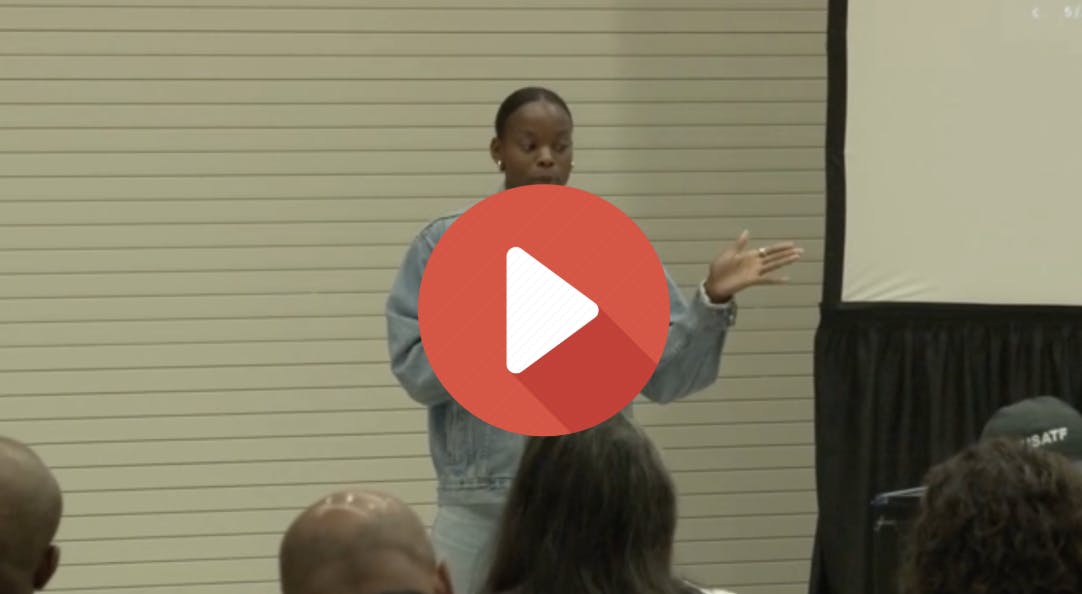
Coach Moore explains that the drive phase of the triple jump is the first third of the approach. Here, the focus needs to be on powerful pushes, which is extremely different than bounding out the back.
The difference is that purposeless bounding is going to take away from momentum rather than increase it into the next phases of the jump. Therefore, each push needs to have a clear intent.
Coach Moore also emphasizes the importance of the very first step because of how it creates consistency and helps solidify the rest of the approach. She also suggests using some type of physical marker on the ground to ensure that the first step is in the right position.
When training this phase of the triple jump, Coach Moore notes that she always focuses on keeping her chest up, because having the chest down typically causes the body to have more of a bounding approach, which isn’t ideal.
Continuation Phase Approach
The next phase Coach Moore discusses is the continuation phase, which follows the drive phase and is focused on covering ground. Her main goal during this phase is to keep running aggressively, which means standing up, being in the correct body posture, nailing the running mechanics, and being keenly aware of where she is on the track.
While mechanics are crucial for every phase in the triple jump approach, Coach Moore seems to think they’re most important during this continuation phase because this is when a lot of fouls and penalties happen, which can derail an entire jump.
Transition Phase Approach
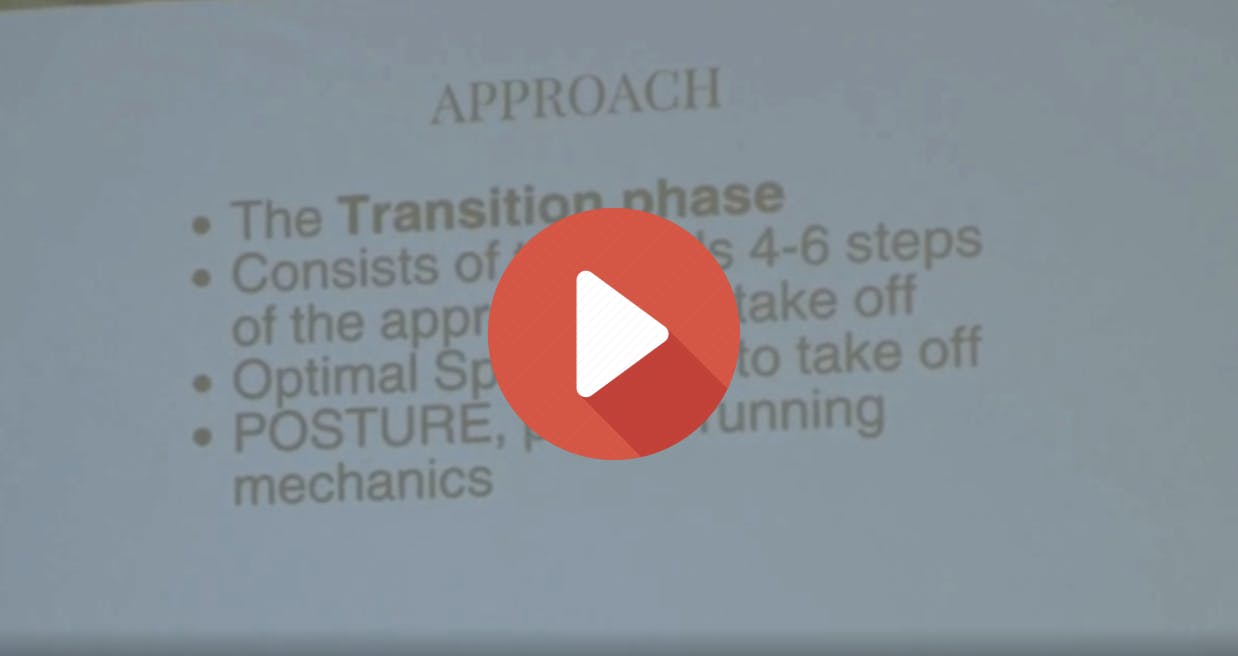
Coach Moore then goes on to discuss the final phase of the triple jump approach, which is the transition phase.
She explains how this phase consists of the last 4 to 6 steps of the approach. The main goal of this phase is to create and maintain the maximum speed possible as one gets to the board and begins the eventual jump.
Coach Moore is a big proponent of having what she calls a “mid mark” during this phase, which is a way to gauge where the runner is in their approach. It should be positioned about five steps out from the jump for each runner, which is about 28 feet for Coach Moore.
If an athlete is on their mid mark perfectly and on the board perfectly, they did their job. But if they end up a foot or so in front of the mid mark but on the board perfectly, the athlete was probably stuttering in their lead-up.
If the athlete is behind the mid mark, then they’re probably reaching, which would also require a mechanical adjustment from the coach.
Coach Moore also reiterates that the athlete’s posture and hips must remain upright as they enter the board, because the chest or hips being down will not lead to an optimal take off.
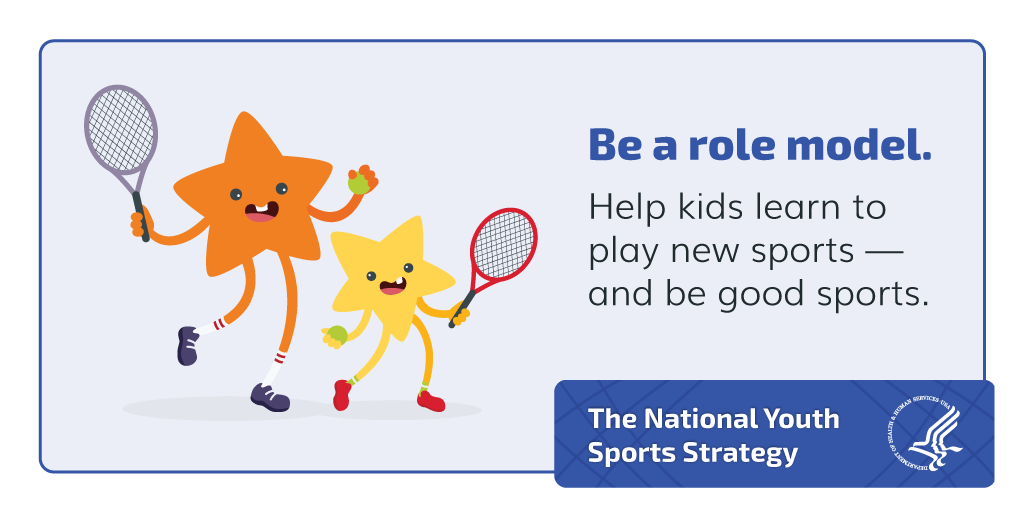
Want to help kids #GetActive through youth sports?
Learn how parents, coaches, and volunteers can get involved in
@HealthGov’s National #YouthSports Strategy: https://bit.ly/2lIHPUcFriday, April 11, 2025
US Sports Tennis: Three of Tennis Whiz Lisa Dodson’s Tips to Improve Serves and Alejandro Davidovich Fokina vs Alexei Popyrin Quarter-Final Highlights
Torpedo Bats, Great Hitting, Or Bad Pitching? Now Streaming On US Sports Radio!
- By Grant Young
The journey from having a good tennis serve to achieving greatness often hinges on the subtle nuances introduced by effective coaching.
While many players may possess the raw talent and basic mechanics necessary for a solid serve, it is the refined details, often highlighted by a knowledgeable coach, that can truly transform performance.
Coaches can offer insights that transcend mere technique, helping players develop a deeper understanding of their own bodies and how they move during a serve. This understanding fosters a greater sense of confidence, encouraging players to trust their instincts and abilities under pressure.
0:00 / 0:00
15 seconds
15 seconds
Additionally, the relationship between a coach and player allows for personalized adjustments, as coaches observe and identify specific areas for improvement. This tailored approach not only enhances a player’s technical skill but also builds a foundation of mental resilience.
Coaches often emphasize the importance of consistency, focus, and strategic thinking, encouraging players to visualize success and embrace a winning mindset. Moreover, a coach’s experience can illuminate the importance of practice—underlining how even the smallest changes can lead to significant improvements.
Through consistent guidance, players learn to embrace the process rather than solely focusing on the outcomes, fostering a mindset for growth.
Ultimately, the small, subtle interventions of a coach can bridge the gap between potential and performance. Their ability to instill confidence, promote understanding, and encourage adaptability allows players to elevate their serves, resulting in a game that isn’t just good, but truly great. In tennis, as in many sports, it’s often the fine details that make all the difference.
This is why tennis coaches must have the right information when it comes to teaching their players how to serve correctly. This is where Lisa Dodson comes in.
Coach Dodson is a certified USPTA Elite Professional with 45+ years of tennis teaching experience. She’s also a former WTA world-ranked player in singles and doubles with broad experience in multiple sports at high levels.
Dodson is the inventor of ServeMaster, an accelerated learning tool that allows tennis players to feel what the serve should feel like without hitting a tennis ball. It can be used anywhere and is easily portable. It is also a multi-sport tool that helps players improve their technique both on and off the courts or playing field.
Coach Dodson’s ‘Serve in 30!’ clinic conveys several valuable tips on how to improve a tennis player’s serve. We’ve pulled three tips and included them for your use below.
Get a Grip on the Serve
The first lesson that Coach Dodson conveys in her clinic is how to properly grip the tennis racket during the serve.
She notes how there’s a left-side bevel and a right-side bevel on the tennis racket’s handle. A right-handed player will want to put their hand a little bit below halfway down the racket, and the right thumb on the left side level and the right index finger on the right-side bevel.
This will create a sort of checkmark between the thumb and index finger, which is ideal for gripping the racket during a serve. It’s important to note that the hand should be left of center on the racket, and not held horizontally, as this will take away from flexibility and strength when executing the serve.
Another important point is that the pinky finger is going to be right above the flared end of the racket. The grip should also be loose and low.
Toss it UP!
Coach Dodson asserts that there are four important things to remember when it comes to the toss.
1. Players want to keep a very light grip on the ball with flat fingers. They should be placed across the first joints of your fingers.
2. They want to keep their wrist pointed downwards.
3. They want to keep a straight elbow throughout the toss.
4. The toss should come completely from the shoulder.
Once these are all nailed down, the player should ensure that their toss is going straight up and down with no spin with no arc, so that it’s sitting there, waiting for the player to hit it at its highest point.
One potentially difficult aspect of the serve is that while the serving arm is going to be rigid, the racket arm should remain as loose and floppy as can be.
A great drill that Coach Dodson recommends is to place a racket’s end right at the edge of where a front foot will be positioned during the serve. Then the ball will be tossed in the air, and if it comes down on the racket head, that’s the perfect height and length for your serve.
Set Your Feet For Power & Rotation

For the platform stance, Coach Dodson suggests a player place their feet a little closer than shoulder width. The left toe goes in the direction of the right net post while the left foot is essentially parallel to the baseline (although this is flipped for left-handed hitters).
From there, a player can get an idea of where their serve will likely be headed by placing their racket down in a straight line with the tips of their shoes. Whatever this line is pointed to is likely where your serve will end up.
Despite
this, Coach Dodson asserts that the stance is very personal, and no two
players stand the exact same way. That’s why players need to experiment
with different stances and see what feels most comfortable. But this is
a good baseline from which to experiment.
Thursday, April 10, 2025
US Sports Lacrosse: How To Perfect Your Skill In Playing Lacrosse and Game Highlights Toronto Rock vs Las Vegas Desert Dogs
Lacrosse is a fast moving sport, and it is also fast growing. If you or someone you know yearns to learn how to play lacrosse, the following procedures briefs you on the basics of this sport. But first, let us take a good short look about lacrosse.
Each opposing teams on a lacrosse field is composed of 10 players, so a field has a total of 20 players. Each team is composed of 3 attackmen, 3 middies, 3 defensemen and 1 goalie.
A game is divided into 4 quarters like basketball, and like all other games, the team scoring the most points at the end of the game emerge as winner.
0:00 / 0:00
15 seconds
15 seconds
A player earns a score by shooting the ball from their stick’s pocket into the opponent team’s goal.
The lacrosse ball is a solid rubber ball about the size of a baseball.
An opponent team can dispossess you of your ball either by hitting you with their stick or with their body. A player has to cradle to prevent the ball from falling out.
It is important that a middie make an outside shooting. The defense can shift their game completely if threatened by a good outside shooting.
A player who has the ball can get past the defenseman by using different dodges such as face doge, split dodge, and bull dodge.
The procedures below outlines step by step the proper way of playing lacrosse.
CHOOSING YOUR STICK. A branded lacrosse stick is quite expensive. If you just want to learn how to play, go to your local sports store, where a basic stick won’t cost you as much as a branded stick. There are three main components of a stick. The Head- this is the piece at the top of the stick used for controlling the ball. The Mesh- this is the rope suff inside the head, also known as the stringing. Finally, The Shaft- it was traditionally made out of wood, but nowadays they are made of strong metal alloys and have varying weights and strength. If your right hand is your good hand, put your left hand on the bottom and right hand on top. Switch for your left hand.
LEARN HOW TO CRADLE. A necessary skill that is important to lacrosse is cradling, which is the equivalent of dribbling in basketball. Cradling is the technique of getting past the defense man without him taking the ball out of your stick. Use centripetal force to keep your ball in place by a curling motion with your wrist. This is best done in front of a mirror while starting. Place the ball in your pocket (the area where the ball sits in your mesh) and hold your dominant hand a few inches below the head. Begin with the head facing the mirror so you can see the ball. Now bring the head across your face while curling the wrist. Keep practicing until you are get used to it. If you find it hard to get the hang of it, try watching some lacrosse dvds until you are familiar with all the game’s moves and techniques.
LEARN TO PASS. In lacrosse, passing is one of the most critical skills to succeed in the game. Passing is used to move the ball up field, catch your opponent out of position while hitting your teammate for an assist, or get yourself out of pressure. Make the head next to your ear and ruffle your wrist of your top while pulling your bottom hand towards you. Don't let it hook around your neck. Be sure to go through with the motion. Eventually, you will get used to how your stick throws and can then adjust the way you throw to be more accurate. You can imp[rove your skills in lacrosse by is getting to a brick wall and playing "wall ball." stand a few feet from the wall and throw the ball against it. Practice catching as the ball bounces back towards you.
BE A GOOD CATCHER. Catching is about hand-eye coordination. Catch the ball in your stick and make sure you don't cradle as it enters your stick. This is called cradle catching and is done by beginners. Instead of cradling, just release your grip on your top hand and as the ball enters the stick give and ease the ball into the stick. Again, wall ball practice is recommended.
GAMES ARE WON AND LOST IN GROUND BALLS, that's a fact. While approaching the ball step to it place your foot near the ball. Sink your hips and put your head parallel to the ground. The butt of your stick have to get down low as well. Scoop through and bring the head to your face. Immediately look for an outlet to a team mate.
PASS, CATCH. AND CRADLE USING BOTH HANDS. Using both hands requires patience, and you have to practice over and over again to learn this skill. A good way to improve your off-hand skills is to look at what your dominant hand is doing. Mirror the way you are passing. Go through the same motions. After doing this, spend a week of practice using nothing but your non-dominant hand. During line drills, 6v6, fast break, only use your off-hand. This will be very frustrating, but keep doing it. It will go a long way in improving your skills.
Noel Guntan is a write for Mondex Professionals US. His current area of interest is in sports supplies and sporting goods
Subscribe to:
Posts (Atom)

